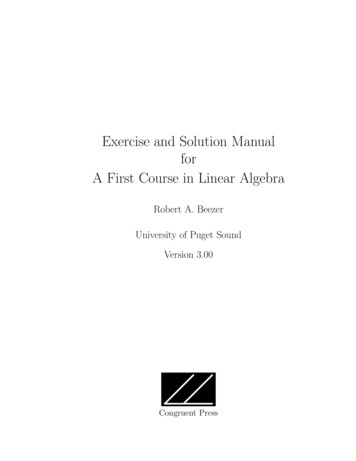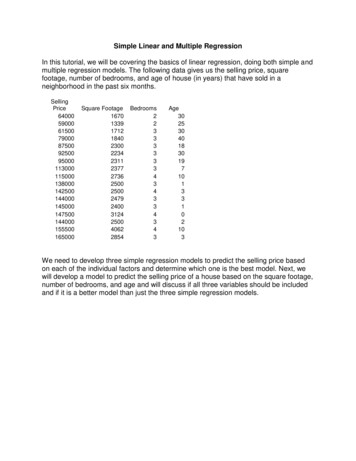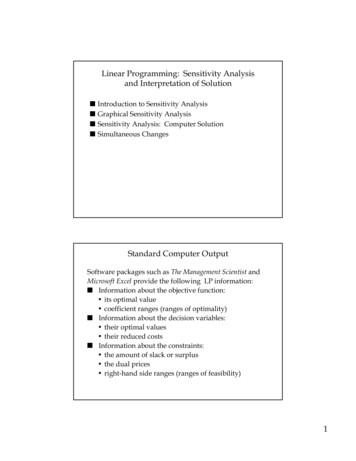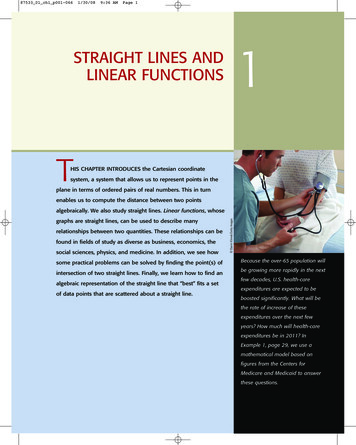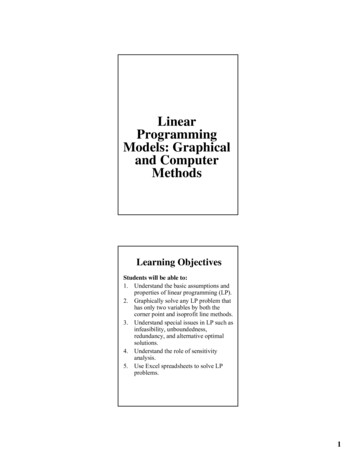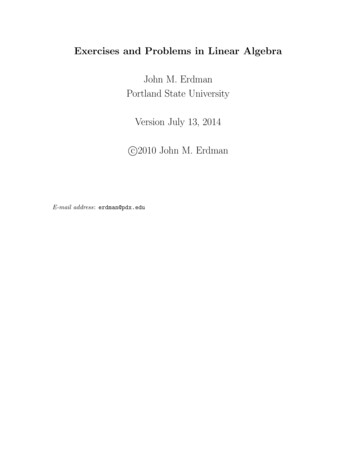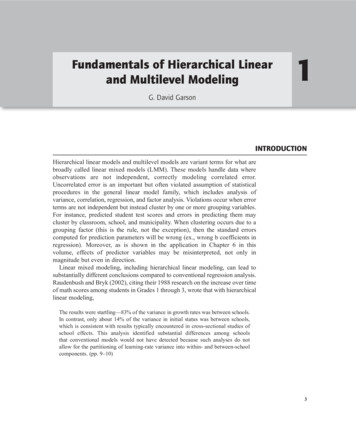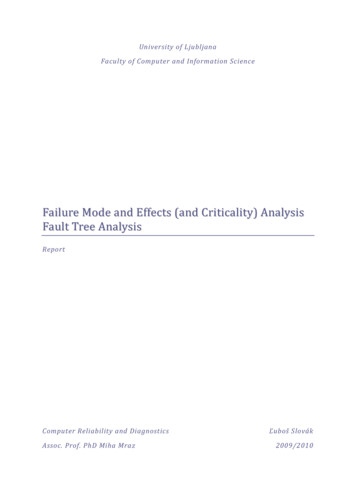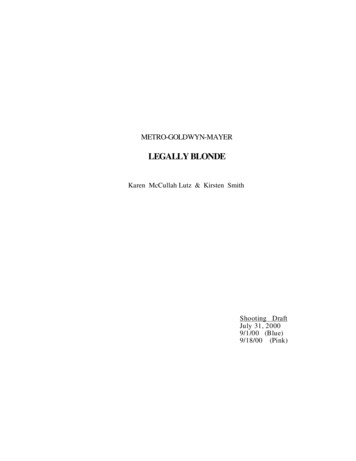
Transcription
Effects of linear and daily undulatingperiodized resistance training programson measures of muscle hypertrophy: asystematic review and meta-analysisJozo Grgic1 , Pavle Mikulic2 , Hrvoje Podnar2 and Zeljko Pedisic112Institute of Sport, Exercise and Active Living (ISEAL), Victoria University, Melbourne, AustraliaUniversity of Zagreb, Faculty of Kinesiology, Zagreb, CroatiaABSTRACTSubmitted 14 April 2017Accepted 25 July 2017Published 22 August 2017Corresponding authorJozo Grgic, jozo.grgic@live.vu.edu.auAcademic editorScotty ButcherAdditional Information andDeclarations can be found onpage 15DOI 10.7717/peerj.3695Copyright2017 Grgic et al.Distributed underCreative Commons CC-BY 4.0OPEN ACCESSBackground. Periodization is an important component of resistance training programs. It is meant to improve adherence to the training regimen, allow for constantprogression, help in avoiding plateaus, and reduce occurrence and severity of injuries.Previous findings regarding the effects of different periodization models on measuresof muscle hypertrophy are equivocal. To provide a more in-depth look at the topic, weundertook a systematic review of the literature and a meta-analysis of intervention trialscomparing the effects of linear periodization (LP) and daily undulating periodization(DUP) resistance training programs on muscle hypertrophy.Materials and Methods. A comprehensive literature search was conducted throughPubMed/MEDLINE, Scopus, Web of Science, SPORTDiscus, Networked Digital Library of Theses and Dissertations (NDLTD) and Open Access Theses and Dissertations(OATD).Results. The pooled standardized mean difference (Cohen’s d) from 13 eligible studiesfor the difference between the periodization models on muscle hypertrophy was 0.02(95% confidence interval [ 0.25, 0.21], p 0.848).Conclusions. The meta-analysis comparing LP and DUP indicated that the effects ofthe two periodization models on muscle hypertrophy are likely to be similar. However,more research is needed in this area, particularly among trained individuals and clinicalpopulations. Future studies may benefit from using instruments that are more sensitivefor detecting changes in muscle mass, such as ultrasound or magnetic resonanceimaging.Subjects Kinesiology, Public HealthKeywords Skeletal muscle, Cross-sectional area, Lean body massINTRODUCTIONRegular participation in resistance training has been recommended to adults seeking generalhealth and fitness by the World Health Organization (2010), US Department of Health andHuman Services (2008), American College of Sports Medicine (2009) and many other globalpublic health authorities. Resistance training is recommended as it may improve musclemass, strength, and bone mass (Petersen, Hastings & Gottschall, 2017). It may also beassociated with greater mobility (Yamamoto et al., 2016), increased health-related qualityHow to cite this article Grgic et al. (2017), Effects of linear and daily undulating periodized resistance training programs on measures ofmuscle hypertrophy: a systematic review and meta-analysis. PeerJ 5:e3695; DOI 10.7717/peerj.3695
of life (Goldfield et al., 2017), increased resting metabolic rate (Campbell et al., 1994), andreduced risk of type 2 diabetes (Grøntved et al., 2012). Population-based studies fromAustralia and the US have found that 18.6% and 31.7% of adults, respectively, participatein muscle-strengthening physical activities at least two times a week (Bennie et al., 2016;Loustalot et al., 2013). Muscle mass is also thought to be an important factor influencingperformance in many sports disciplines, particularly in physique sports (e.g., bodybuilding,men’s physique, etc.). Resistance training designed to promote muscle hypertrophy is,therefore, for many athletes an important part of their training regimen.According to Haff & Triplett (2016), periodization enables systematic, sequential,and integrative scheduling and programming of training sessions to maximize specificphysiological adaptations underpinning performance outcomes. Commonly used formsof periodization are the linear or classic periodization model (LP) and the nonlinear orundulating periodization model. According to Rhea and colleagues (Rhea et al., 2002),LP gradually increases training intensity and decreases volume, with these changes beingmade approximately every four weeks. A nonlinear form of periodization was previouslydescribed by Poliquin (1988) and is characterized by more frequent alterations in intensityand volume. The undulating periodization models can be performed on a weekly or dailybasis. Daily fluctuations in intensity and load are often referred to as ‘‘the daily undulatingperiodization’’ (DUP), while the periodization with weekly fluctuations is termed ‘‘theweekly undulating periodization’’ (WUP).The current empirical evidence provides insights regarding training frequency(Schoenfeld, Ogborn & Krieger, 2016), volume (Schoenfeld, Ogborn & Krieger, 2017), restintervals (Schoenfeld et al., 2016b), and repetition ranges (Schoenfeld et al., 2016a). Despitethese evidence-based general suggestions for designing a training protocol for musclehypertrophy, there is a paucity of evidence regarding different periodization strategies.It seems that most resistance training programs utilize some form of periodization, butit is still unclear whether the effectiveness of periodization is mainly related to the principleof specificity when analyzing strength (Mattocks et al., 2016), or more determined by thevarying structure of the training programs and the differences in the volume of training(Kok, Hamer & Bishop, 2009). A recent systematic review and meta-analysis by Harries,Lubans & Callister (2015) found no significant differences between LP and undulatingperiodization models in increasing upper- and lower-body strength. However, the studydid not analyze whether the two types of periodization differ in their effects on musclehypertrophy. Findings about the effects of these two forms of periodization in volumeequated comparisons on muscle hypertrophy seem to be equivocal, with some studiesindicating greater benefits from the DUP model (Simão et al., 2012; Spineti et al., 2014) andothers demonstrating no significant differences (De Lima et al., 2012; Prestes et al., 2015).To provide a better understanding of the current evidence regarding the LP and DUPmodels and their effects on measures of muscle hypertrophy, we conducted a systematicreview of the literature coupled with a meta-analysis. A more informed understanding ofthe topic may be of benefit to personal trainers and strength and conditioning coaches,professional athletes competing in many sports, and millions of those participating inmuscle-strengthening activities for recreational and/or health purposes (Bennie et al., 2016;Grgic et al. (2017), PeerJ, DOI 10.7717/peerj.36952/20
Centers for Disease Control and Prevention, 2013; Harada et al., 2008; Loustalot et al., 2013;Schoenborn, Adams & Peregoy, 2013). The focus of this paper was on LP and undulatingperiodization, specifically, DUP, as these models are most commonly used in interventionstudies examining the impact of periodization on muscular adaptations (Harries, Lubans& Callister, 2015).MATERIALS AND METHODSThe methods were specified in advance in the PROSPERO International prospectiveregister of systematic reviews (ref: CRD42016047795).Search strategyA systematic literature search was conducted according to the guidelines for PreferredReporting Items for Systematic Reviews and Meta-Analyses (PRISMA) (Moher et al., 2009).A comprehensive search of the PubMed/MEDLINE, SCOPUS, Web of Science (includingScience Citation Index Expanded, Social Sciences Citation Index, and Arts & HumanitiesCitation Index), SPORTDiscus, Networked Digital Library of Theses and Dissertations(NDLTD) and Open Access Theses and Dissertations (OATD) databases was conducted.In all databases, a search through titles, abstracts, and keywords of indexed documentswas performed from the inception of indexing to September 14th, 2016, by combining thesearch terms for periodization (periodis* and periodiz*) with the following search terms:resistance training; muscle hypertrophy; strength training; muscle mass; skeletal muscle;cross-sectional area; body composition; strength exercise; strengthening exercise; resistanceexercise; weight training; weight lifting; muscle strengthening; muscular strengthening;muscle training; muscle exercise; muscle toning; muscle gain; muscle volume; weightbearing exercise; weight bearing training; bodybuilding; body building. The full syntaxwith Boolean operators used for the literature search may be found in Appendix S1. Aspart of the secondary search, we also screened the reference lists of all selected documentsand the studies that have cited the included studies.Inclusion criteriaStudies were assessed for eligibility based on the following inclusion criteria: (a) anexperimental trial published in an English-language peer-reviewed journal or a doctoralthesis; (b) it compared the use of a LP resistance training program to a DUP resistancetraining program or to a mixture of WUP and DUP resistance training program in atraditional dynamic resistance exercise using coupled concentric and eccentric muscleactions; (c) the study used at least one method of estimating changes in muscle mass(studies using only measures of circumference without controlling for body fat changeswere excluded as they do not provide an accurate assessment of changes in lean body mass);(d) the volume was equated between the different periodization models; (e) the study lastedfor a minimum of six weeks and involved participants with no musculoskeletal injury orany other health condition that could directly or through medications associated withthe management of a given condition be expected to impact the hypertrophic responseGrgic et al. (2017), PeerJ, DOI 10.7717/peerj.36953/20
to resistance exercise (i.e., coronary artery disease and angiotensin receptor blockers), asdone in previous research examining muscle hypertrophy (reviews Schoenfeld, Ogborn &Krieger, 2017).Study selectionThe study selection was conducted independently by two authors (JG and HP) in order tominimize potential selection bias. Disagreements between the investigators were resolvedthrough discussion and mutual consensus, and any remaining disagreements were settled bythe third investigator (PM). Studies were excluded based on their title or, where necessary,by reading the abstract or full text. Attempts were made to contact authors to provide anyadditional data needed for a given study to meet the inclusion criteria.Study coding and data extractionThe studies meeting the inclusion criteria were read and independently coded by twoinvestigators (JG and HP) using a predefined spreadsheet. The following data was extracted:(a) descriptive information of participants by gender, age (ages 10–18 years were classifiedas adolescents, aged 19–39 classified as young adults, aged 40–64 classified as middle-agedadults, aged 65 classified as elderly), and experience in resistance training (classified asuntrained if they had 1 year of experience and as trained if they had 1 year of experience);(b) the number of participants in each group; (c) the type of study design; (d) the durationof the intervention trial; (e) the characteristics of both resistance training models; (f)the type of morphologic measurements (skinfolds, circumferences, ultrasound, magneticresonance imaging—MRI, dual energy X-ray absorptiometry—DXA, air displacementplethysmography— BOD-POD, and/or bio-impedance analysis—BIA); (g) the region ofthe body measured for the studies that used skinfolds, circumferences, ultrasound or MRI;and (h) main findings related to muscle hypertrophy. Coding was crosschecked betweenthe coders, and all discrepancies were resolved through discussion. The assessment ofpotential coder drift was performed by randomly selecting 30% of the studies for recoding,as described by Cooper, Hedges & Valentine (2009).Quality assessmentTo assess the methodological quality of the studies, we used the PEDro Scale (Maher et al.,2003). The PEDro scale is a 11-criteria checklist for assessing the methodological quality ofrandomized controlled trials. Studies are awarded 0–10 points, depending on the numberof criteria they meet (the first item is not used to calculate the summary score). Due tothe nature of exercise interventions, no included studies could theoretically do blinding ofsubjects and investigators, and hence none could earn points on the PEDro Scale items 5and 6. In addition to presenting the overall PEDro Scale score, we therefore also presentedthe percentage of the maximal possible score, which is 8 points. Details about the scale itemscan be found elsewhere (Maher et al., 2003). The same authors that performed the searchand coding of the studies independently completed the PEDro Scale. Any disagreementwas resolved by mutual consensus or by consensus with a third investigator (PM).Grgic et al. (2017), PeerJ, DOI 10.7717/peerj.36954/20
Statistical analysisDifferences in the pre-post data for each individual study and measured muscle group werecalculated as a percent change as follows:(Post-training measure Pre-training measure)/Pre-training measure 100.A meta-analysis was performed using the ‘‘Comprehensive Meta-analysis’’ software (BiostatInc., Englewood, NJ, USA). The data entry format that was used for the calculation ofstandardized mean differences (Cohen’s d [SMD]) and its 95% confidence interval (CI)was ‘‘means, standard deviation (SD) pre and post, sample size (n) in each group, pre/postcorrelation’’. As none of the studies reported correlation and it could not be estimated withhigh precision (Borenstein et al., 2009) the data was standardized by post score SD values.When the data is standardized by post score SD, the correlation values are not needed forthe calculation of SMDs. Unlike th
method provides more insights regarding the variability of the training effect (Dankel et al., 2017c). In LP vs. DUP comparisons, where the data showed a greater increase from pre to post values for the LP group, this was expressed as the positive effect direction, and where the data showed a greater increase from pre to post values for the DUP group, this was expressed as the negative effect .
